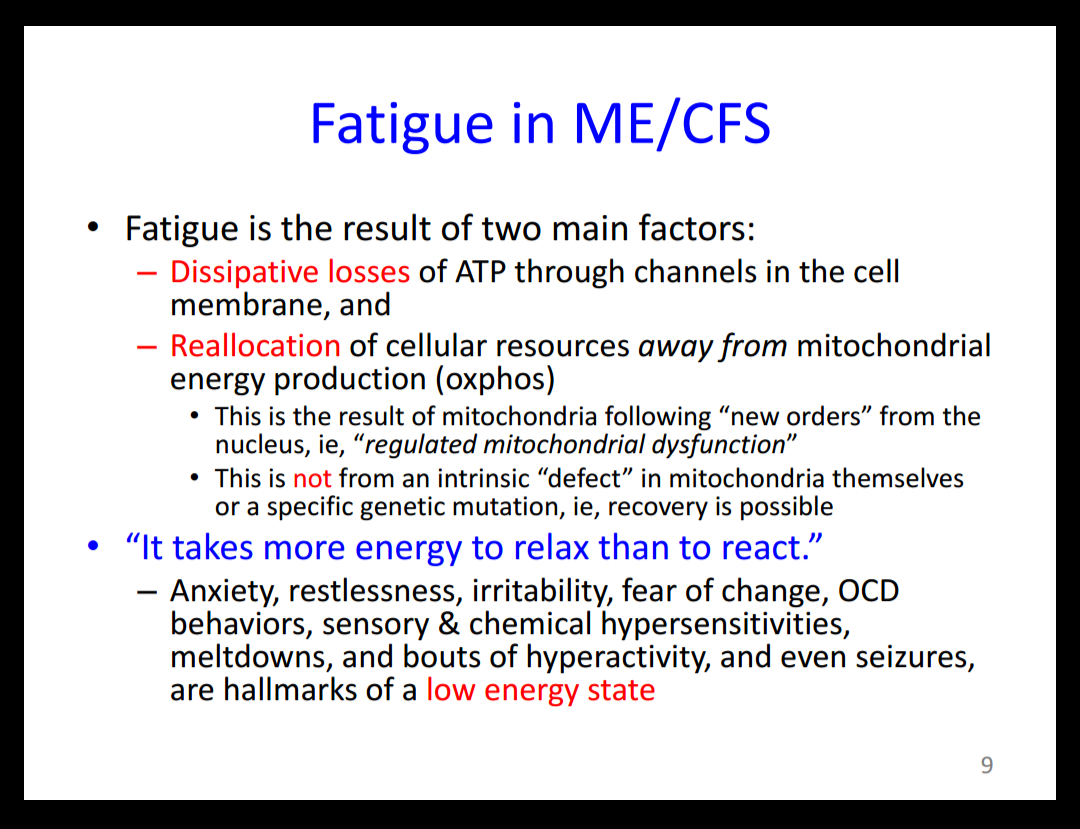Learner1
Senior Member
- Messages
- 6,305
- Location
- Pacific Northwest
Sorry, I've been under the weather the last couple of days after IVIG and IV antibiotics for my ME/CFS... spent last night in the ER. I tend to believe there's an infectious component...
Can we go back to this from @duncan 's post above?
I'm seeing a top ME/CFS specialist who also diagnosed me with multiple chronic infections, low immune function AND the adrenergic and muscarinic antibodies linked to POTS and ME/CFS.
Given this, I had an interesting chat with Jarred Younger at the OMF Symposium...he's the researcher who found 2 subsets - infectious and autoimmune:
I shared my test results and said, "can there be a third group of us with BOTH infections and autoimmunity?" He said that there definitely could be.
Given what is out there, I tend to believe that Naviaux is right and it doesn't matter what the triggers are, some will be infectious, some toxicity, some autoimmunity, and others from his list of cell dangers. And a lot of us will have multiple triggers.
Both my doctor and Mark Davis indicated that these infections can stress cells to provoke the production of autoimmune antibodies. Sometimes the infections go away and just the antibodies remain, but others are left with both. Though its pretty hard, if not impossible for viruses to be gone for good. They can reactivate at any time, and they attack different areas of the body - the heart, the liver, the brain, the stomach, etc.
Seems like the things that are important are removing the cell dangers, calming inflammatory and autoimmune processes and fixing collateral damage, not excluding people from the group because they don't have the same exact triggers... we're all individuals with unique environmental exposures and genetics... though we share the same symptoms.
Can we go back to this from @duncan 's post above?
Basilico said: ↑
Actually, Ron Davis did prove that CFS is not the result of an infection in the blood. He searched for viral DNA (which is much more precise and accurate than looking for antibodies as most CFS docs are currently doing) and he couldn't find anything significant - the healthy controls actually had slightly more evidence of viral infection than severe CFS patients.
Duncan said: ↑
This does not prove ME/CFS is not the result of an infection in the blood. Obvious exceptions could be - and I emphasize could - Borrelia and certain enteroviruses.
Basilico said: ↑
While it is possible that there's an infection that can only be detected in the tissues (or maybe hiding in the vagal nerve), after listening to what he's learned so far, an infection seems unlikely. When he took cells from a severe CFS person and put them in the plasma of a healthy person, those cells behaved like a perfectly healthy cell. So he knows there's a problem with something in the plasma but not in the cells - I don't think this is consistent with a viral infection (which highjacking cells).
Duncan said: ↑
I think this is a very valid point, and I think it strongly supports an autoimmune etiology. But I fear it may not be a slam dunk, especially if there is a paucity of truly investigative efforts for some potential infectious culprits.
I like Davis's and Naviaux's positions, and I think they may be right. But I still am concerned that they have not disproven an infectious agent is at play for at least a significant subset of pwME.
I'm seeing a top ME/CFS specialist who also diagnosed me with multiple chronic infections, low immune function AND the adrenergic and muscarinic antibodies linked to POTS and ME/CFS.
Given this, I had an interesting chat with Jarred Younger at the OMF Symposium...he's the researcher who found 2 subsets - infectious and autoimmune:
I shared my test results and said, "can there be a third group of us with BOTH infections and autoimmunity?" He said that there definitely could be.
Given what is out there, I tend to believe that Naviaux is right and it doesn't matter what the triggers are, some will be infectious, some toxicity, some autoimmunity, and others from his list of cell dangers. And a lot of us will have multiple triggers.
Both my doctor and Mark Davis indicated that these infections can stress cells to provoke the production of autoimmune antibodies. Sometimes the infections go away and just the antibodies remain, but others are left with both. Though its pretty hard, if not impossible for viruses to be gone for good. They can reactivate at any time, and they attack different areas of the body - the heart, the liver, the brain, the stomach, etc.
Seems like the things that are important are removing the cell dangers, calming inflammatory and autoimmune processes and fixing collateral damage, not excluding people from the group because they don't have the same exact triggers... we're all individuals with unique environmental exposures and genetics... though we share the same symptoms.
Last edited:

